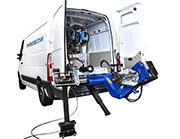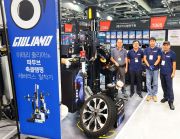
Why are tires so important?
What's the real importance of tires? Federpneus (National Association of Tire Sales Specialists) and Assogomma (National Association of Tire Manufacturers) are pushing on this important question through two separate initiatives.
"Safe winter" focuses on the effectiveness of winter tires when the temperature drops below 7°C.
A series of tests (including driving and instrumental testing), conducted on the snowy roads of Stelvio pass (2750 metres above sea level), allowed to establish that the best solution, from a safety stand point, is to fit winter tires as a full set of four.
Instrumental and drive tests have been performed in two days, under different weather conditions, on four Alfa Romeo 159 JTD cars, equipped with:
- Winter tires;
- Experimental tires with winter rubber compound and summer tread pattern;
- Experimental tires with summer rubber compound and winter tread pattern;
- Summer tires.
Test results were as follows:
- Vehicle installing experimental tires with winter rubber compound and summer tread pattern had braking distance to stop the vehicle which was 33% higher than the one for the same vehicle equipped with winter tires;
- Vehicle installing experimental tires with summer rubber compound and winter tread pattern had braking distance to stop the vehicle which was 110% higher than the one for the same vehicle equipped with winter tires (that is to say, more than double);
- Vehicle equipped with summer tires showed the worst performance. It had a braking distance to stop which was 122% higher than the one for the same vehicle equipped with winter tires.
It is clear that the advantage of winter tires is provided by the sum of two elements: compound and tread (both design and sipes). Tread itself is not enough, as a different compound materials composition is also necessary.
Two "seasonal" configurations and one " hybrid" have been really put to the test on curves and winding roads with U-turns at a 30 km/h speed, as tests have been conducted on three Fiat 500 Abarth cars equipped with: 4 winter tires; 4 summer tires; two winter tires on the drive axle and two summer tires on the driven axle. The vehicle equipped with summer tires in all situations had unpredictable behaviour in all situation, but with great surprise, the "mixed" configuration proved to be the most dangerous, as it provided a false sense of security (combined good grip on straight roads and loss of safety on turns).
In accordance with Directive issued by Ministry of Transport on January 30th, 2013, winter tires must be fitted in complete sets of four, in order to ensure maximum safety for the vehicle occupants. The performance of winter tires is higher even when the tread is worn out (within the limit allowed by law) with a performance drop of 10% (compared to the new set of four) against the higher performance drop of summer tires (30% compared to a new set of four).
Can 4WD compensate this lack of safety without winter tires? Two Toyota Rav 4, one equipped with summer tires and one with winter tires, showed how different each behaviour can be on the road, and how 4WD only would be insufficient to grant safety.
The conclusion, as expected, is only one: to ensure the highest safety and the best possible performance during winter time, you must make sure your set of winter tires has not only the Winter Tread Pattern and M+S (Mud & Snow) marking, as provided for by law, but also make sure that the rubber compound of your tires is intended for winter (i.e. tires carry the 'three peak mountain/snowflake' sidewall marking).
Federpneus, with the "Mind the tires" initiative and this related funny video, wanted to emphasize how important is, for your safety, to rely on technically qualified and reliable tire fitting partners.
tires are the only point of contact between your vehicle and the road (0,12 sqm) and your choice upon this product, as well as its quality and maintenance, influence your comfort and safety.
Only qualified professionals must perform maintenance and fitting of your tires. State of the art equipment should also be used, such as the Giuliano Industrial's CROSSAGE EVO tire changer. The bead breaker arm with two disks helps loosing the bead in every point of tire in a more sensitive, regular and effective way without risk of damaging the sidewall of the tire. QX innovative no contact mounting/demounting system avoids any use of conventional tire bar. Powerful and easy to use without efforts for the operator, suitable for the most hard and difficult tires, such as low profiled, UHP and RunFlat.




